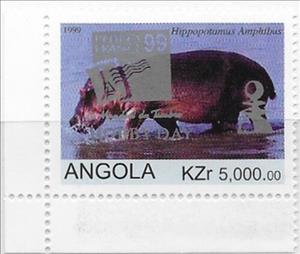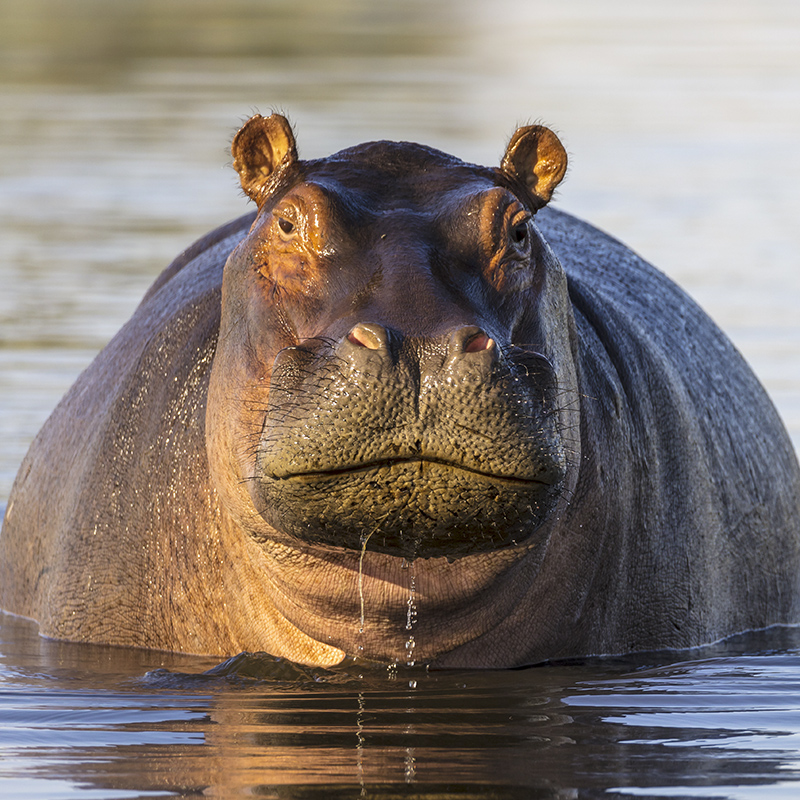Stamp: Flora and Fauna (Hippopotamus amphibus) Overprint (Angola 1999)
Flora and Fauna (Hippopotamus amphibus) Overprint (Angola 1999)
01 January (Angola ) within release Flora and Fauna (1999) goes into circulation Stamp Flora and Fauna (Hippopotamus amphibus) Overprint face value 5,000 Angolan kwanza
| Stamp Flora and Fauna (Hippopotamus amphibus) Overprint in catalogues | |
|---|---|
| Colnect codes: | Col: AO 1999-34/2 |
Stamp is square format.
• With silver overprinted "Hobby Day 1999". This item has been denounced in Scott Catalog as illegally produced without the authorization of the postal administration. They have no postal validity. Scott Catalog notes that the series was previously listed as Sn:1067-1078 and then removed. This item was Sn:1067. Please view Angola stamps in the main stamp category to see validated stamp issues. Produced by the British counterfeit producer and still being distributed by associated counterfeit stamp dealers to this day. BEWARE of fake First Day Covers. Avoid sellers of these!Also in the issue Flora and Fauna (1999):
- Mini Sheet - Flora and Fauna (Hippopotamus amphibus) face value 9*5000;
- Stamp - Flora and Fauna (Hippopotamus amphibus) Overprint face value 5,000;
- Stamp - Flora and Fauna (Hippopotamus amphibus) Overprint face value 5,000;
- Mini Sheet - Flora and Fauna Aleunia Aurantia face value 9*10000;
- Stamp - Flora and Fauna Aleunia Aurantia Silver Overprint face value 10,000;
- Mini Sheet - Flora and Fauna Blue Wildebeest (Connochaetes taurinus) face value 9*20000;
- Stamp - Flora and Fauna Blue Wildebeest (Connochaetes taurinus) Ovpt face value 20,000;
- Stamp - Flora and Fauna Blue Wildebeest (Connochaetes taurinus) Ovpt face value 20,000;
- Mini Sheet - Flora and Fauna Cheetah (Acinonyx subarus) face value 9*100000;
- Stamp - Flora and Fauna Cheetah (Acinonyx subarus) Overprint face value 100,000;
- Stamp - Flora and Fauna Cheetah (Acinonyx subarus) Overprint face value 100,000;
- Mini Sheet - Flora and Fauna Goldcrest face value 9*50000;
- Stamp - Flora and Fauna Goldcrest face value 50,000;
- Stamp - Flora and Fauna Goldcrest face value 50,000;
- Mini Sheet - Flora and Fauna Mushrooms (Mycena Alcalina) face value 9*25000;
- Stamp - Flora and Fauna Mushrooms (Mycena Alcalina) Overprint face value 25,000;
- Mini Sheet - Flora and Fauna Mushrooms (Sarpocom Inbricatum) face value 9*125000;
- Stamp - Flora and Fauna Mushrooms (Sarpocom Inbricatum) Overprint face value 125,000;
- Mini Sheet - Flora and Fauna Mushrooms (Stropharia aeruginosa) face value 9*250000;
- Souvenir Sheet - Flora and Fauna Mushrooms (Stropharia aeruginosa) Overprint face value 250,000;
- Mini Sheet - Flora and Fauna Water Rail face value 9*150000;
- Stamp - Flora and Fauna Water Rail Overprint face value 150,000;
- Stamp - Flora and Fauna Water Rail Overprint face value 150,000;
- Souvenir Sheet - Flora and Fauna Whinchat Overprint face value 300,000;
- Stamp - Flora and Fauna Whinchat Overprint face value 300,000;
- Mini Sheet - Flora and Fauna White Rhinoceros (Ceratotherium Sihum) face value 9*200000;
- Stamp - Flora and Fauna White Rhinoceros (Ceratotherium Sihum) Ovpt. face value 200,000;
- Stamp - Flora and Fauna White Rhinoceros (Ceratotherium Sihum) Ovpt. face value 200,000;
- Stamp - Flora and Fauna Yellow Billed Stork (Mycteria ibis) Overprnt face value 15,000;
- Stamp - Flora and Fauna Yellow Billed Stork (Mycteria ibis) Overprnt face value 15,000;
Stamp Flora and Fauna (Hippopotamus amphibus) Overprint it reflects the thematic directions:
Animals are multicellular, eukaryotic organisms of the kingdom Animalia (also called Metazoa). All animals are motile, meaning they can move spontaneously and independently, at some point in their lives. Their body plan eventually becomes fixed as they develop, although some undergo a process of metamorphosis later on in their lives. All animals are heterotrophs: they must ingest other organisms or their products for sustenance.
The hippopotamus (Hippopotamus amphibius; /ˌhɪpəˈpɒtəməs/; pl.: hippopotamuses), often shortened to hippo (pl.: hippos), further qualified as the common hippopotamus, Nile hippopotamus and river hippopotamus, is a large semiaquatic mammal native to sub-Saharan Africa. It is one of only two extant species in the family Hippopotamidae, the other being the pygmy hippopotamus (Choeropsis liberiensis or Hexaprotodon liberiensis). Its name comes from the ancient Greek for "river horse" (ἱπποπόταμος).
Mammals are any vertebrates within the class Mammalia (/məˈmeɪli.ə/ from Latin mamma "breast"), a clade of endothermic amniotes distinguished from reptiles (including birds) by the possession of a neocortex (a region of the brain), hair, three middle ear bones and mammary glands. All female mammals nurse their young with milk, secreted from the mammary glands. Mammals include the largest animals on the planet, the great whales. The basic body type is a terrestrial quadruped, but some mammals are adapted for life at sea, in the air, in trees, underground or on two legs. The largest group of mammals, the placentals, have a placenta, which enables the feeding of the fetus during gestation. Mammals range in size from the 30–40 mm (1.2–1.6 in) bumblebee bat to the 30-meter (98 ft) blue whale. With the exception of the five species of monotreme (egg-laying mammals), all modern mammals give birth to live young. Most mammals, including the six most species-rich orders, belong to the placental group. The largest orders are the rodents, bats and Soricomorpha (shrews and allies). The next three biggest orders, depending on the biological classification scheme used, are the Primates (apes and monkeys), the Cetartiodactyla (whales and even-toed ungulates), and the Carnivora (cats, dogs, seals, and allies).



